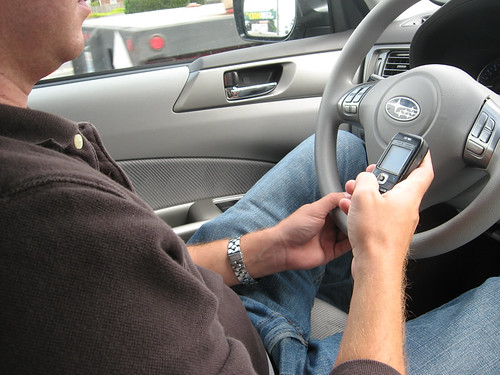Texting and driving is a big problem with teens as well as adults. According to PEW’s November 2009 report, “Teens and Distracted Driving:”
- One in three (34%) texting teens ages 16-17 say they have texted while driving. That translates into 26% of all American teens ages 16-17.
- 48% of all teens ages 12-17 say they have been in a car when the driver was texting.
- 40% say they have been in a car when the driver used a cell phone in a way that put themselves or others in danger.
These statistics should get our attention, but in many cases they don’t. Different organizations are attempting to leverage the power of online video to stop this dangerous behavior. Public service announcements (PSAs) which show (in some cases) graphic depictions of violence are controversial and raise questions about the propriety of using shocking images to motivate people to change their unsafe behaviors.

![]() photo credit: indyplanets
photo credit: indyplanets
In August of 2009, MSNBC published the article, “Is PSA about texting while driving too graphic?” about a video originating out of Gwent, Wales. Some versions of the video have been pulled from YouTube for terms violations. This version, “PSA Texting while Driving U.K. Ad [HD]” is still available. WARNING: This video includes a graphic depiction of a multi-car accident in which several actors are killed.
The state of Utah has launched its “Zero Fatalities” campaign which includes the following fifteen minute video, also aimed at changing teen and other adult drivers’ behavior with respect to texting while driving.Oklahoma librarian Whitney Allen created the Ning project website, “Don’t Text and Drive” to focus student attention on the issue of texting and driving. Students from Indiana, Washington, Michigan, and Oklahoma are currently participating, and more are invited to join.
In her K12Online09 presentation, “Digiteens: Digital Citizenship by Digital Teenagers,” Georgia teacher and noted edublogger Vicki Davis (CoolCat Teacher) showcased several PSA videos created by her students, including one persuading others not to text and drive.
What do you think of PSAs like the Gwent, Wales, video which are graphic and disturbing? MADD (Mother’s Against Drunk Driving) received criticism in the 1980s and 1990s, as I recall, for using graphic images at times to bring attention to the problems associated with mixing alcohol and driving. When you see videos or images like these, it is hard NOT to pay attention. Where do we draw the line when it comes to attention-getting PSAs, however? How is YouTube drawing that line? The stakes are high, so perhaps the line should be at least a bit beyond the range where we are “comfortable” watching a video. We SHOULD be disturbed by the violence and destruction which results from both drinking and driving and texting while driving, and be motivated to change our behavior if we have done these things in the past.
Technorati Tags:
video, youtube, text, texting, driving, violence, psa, gwent, wales, controversy, project
If you enjoyed this post and found it useful, subscribe to Wes’ free newsletter. Check out Wes’ video tutorial library, “Playing with Media.” Information about more ways to learn with Dr. Wesley Fryer are available on wesfryer.com/after.
On this day..
- Eric Curts Shares Google Tools at #NCTIES23 – 2023
- Learning at the March Oklahoma STEM Consortium Meeting – 2018
- CoWorking Spaces in Oklahoma City (March 2015) – 2015
- Impressed with Freshpaint App For Windows 8 (Microsoft Surface Tablet) – 2013
- How Can I Webstream an Event? – 2013
- A Creative ePub Audio Story Powered by Five Card Flickr Story – 2012
- Creating Educational Videos for YouTube by Marty Brandl – 2012
- Catherine Orenstein on the Power and Importance of Female Storytellers – 2011
- Sunset over a sea of clouds – 2011
- Guerrilla Health Message Marketing – 2011

Comments
3 responses to “PSAs to stop texting and driving”
Wes, did you see Alec Couros’ post?
http://educationaltechnology.ca/couros/1754
He addressed this well I think.
No I didn’t see that, Dean, thanks for pointing me to it!
My students discussed this issue. They thought the PSA in question was very disturbing, but they argued that that was what made it effective. They also used http://www.xtranormal.com to create PSAs about texting while driving.